| 1 | An isolated coral reef dweller |
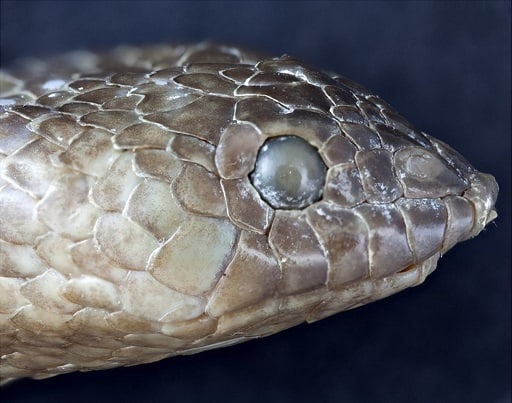
Australia is estimated to have 36 species of true sea snake, over half of the world’s 70 total species. Part of the reason is the abundance of coral reefs and other underwater reefs, each one being an explosion of colourful underwater life with the ecological density of a rainforest. Countless species take advantage of these intricate reefs, and one is the leaf-scaled sea snake (aipysurus foliosquama), a member of the 9-strong Aipysurus family.
This 60cm long species lives off the northwest coast of Australia, most famously the highly isolated, shallow reef islands of Ashmore and Cartier. They’re rarely found in the dark, unknowable depths of the oceans, always in shallow reef linings or sea grasses, blending in with neon-coloured sea life such as its fish prey.
Aipysurus foliosquama has never been recorded at depths below 10 metres, and must surface every 30 minutes to 2 hours to breathe. This even includes while mating. The species can mate for hours at a time, and the male and female are sometimes forced to float to the surface to breathe before slowly descending again, while constantly intertwined with each other. The female is believed to control the rising and falling.
Despite its proximity to the surface, leaf-scaled sea snakes are remote enough that ordinary Australians would never encounter one except on remote fishing expeditions.
| 2 | Neurotoxic venom |
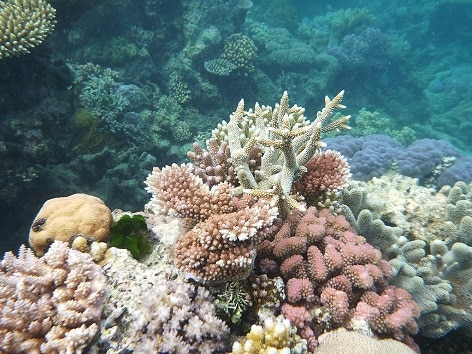
The leaf-scaled sea snake’s remoteness means that tales of bites are few and far between. What is known is that it’s fully capable of causing death. Aipysurus foliosquama kills its prey via venom rather than constriction, and that venom is packed with neurotoxins, which ripple through the body causing convulsions and uncontrollably twitching muscles.
Luckily, the only group at serious risk of a bite is fishermen in small vessels, who once patrolled the nearby reefs looking for shark fins and sea cucumbers (before being banned in 2002). The LD50 potency rating is one missing piece of data, but the venom yield is a tiny 0.48mg, compared to 350mg for the African puff adder.
Aipysurus foliosquama hunts its prey down via stalking them through the nooks and crannies of coral reefs, like its own version of an urban jungle. Like the banded sea krait, their specific method is poking their head into dark holes and crevices, to flush out the fish dwelling inside. If it strikes lucky, then its jaws will brush against a fish immediately, and an envenomating bite will take care of the rest.
| 3 | Has an offshore fortress |
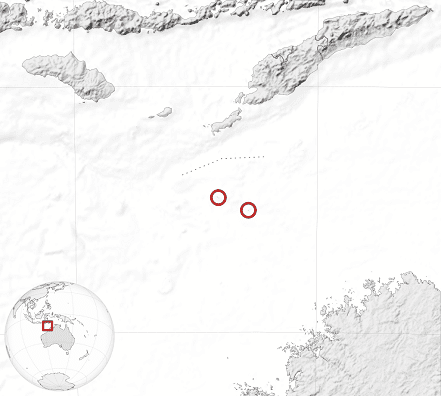
Aipysurus foliosquama was discovered in 1926, and until recently it was known only from one location: the Ashmore and Cartier Islands. These remote islands lie 300 miles off the north coast of Australia, and consist of wide, shallow reefs on a bank above the deeper surrounding ocean. These banks summit in 4 tiny, sandy islands which poke just above the ocean surface. The Ashmore zone consist of a west, central and east islet, with the waters inbetween being shallow and filled with exotic sea-life (and snakes), in the classic image of a sun-drenched topical resort with wooden walkways and straws in coconuts, except that these islands are in the middle of nowhere.
The 4 collective islands are clustered within a 12 mile radius, and were the sole known range of the leaf-scaled sea snake for decades. For millions of years, the species lay here undiscovered to humans, unlike boomslangs or banded sea kraits, which prehistoric humans almost certainly knew well and feared. Indonesian fishermen first visited the reefs in the early 18th century, so it’s possible that no human being laid eyes on the leaf-scaled sea snake until 300 years ago.
| 4 | Always accompanied by bubbles |
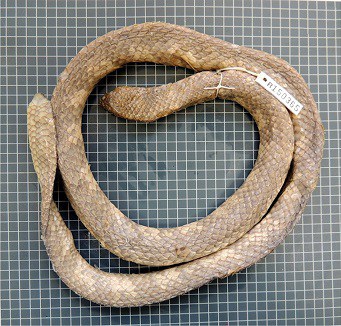
The turtleheaded sea snake (e. annulatus) always exhales after it comes to surface to breathe, making a sound loud enough for nearby scientists to hear. The leaf-scaled sea snake is different – it exhales before it swims upwards, meaning that the species is always accompanied by a volley of popping bubbles when its pokes its head above the surface.
Some sea snakes are hunted by patient eagles which hover over the sea, scanning the surface for prey. Whether Aipysurus foliosquama is eaten by birds isn’t confirmed, but they’re not immune to the weird and wacky nature of coral reefs. Leaf-scaled sea snakes have the unusual danger of algae and barnables gluing to their scales and growing on them. As an evolutionary response, the leaf-scaled sea snake sheds its skin much more frequently than other species, once every 6 to 8 weeks.
On the other hand, they breed less commonly than other snakes, probably less than once per year. Despite weighing only 1 pound, their pregnancy takes two thirds the time of a human at 6 months. At 8-10 years, the leaf-scaled sea snake has a decent lifespan in their natural reef habitats, although this doesn’t come close to the ball python (with a 63 year record in captivity).
| 5 | May have declined by 90% |
The leaf-scaled sea snake is regarded as a critically endangered snake. In a blow for any snake enthusiast hoping to journey to Ashmore Reef in a rowing boat, their numbers have inexplicably plummeted since the 1990s. Ashmore Reef was extensively surveyed from 1994 to 1998, and at this point the species made up 17% of sea snakes observed at high tide and 49% of sea snakes observed at low tide. This led to a healthy population estimate of 6600 on Ashmore Reef.
Nobody suspected that the species was in trouble, but despite surveys continuing every year or two years until 2007, not a single leaf-scaled sea snake was observed from 2001 onwards. They had mysteriously abandoned their age-old tropical reef heartland, akin to the penguins deciding that Antarctic ice shelves were getting boring. A survey in 2005 analysed Ashmore reef for 44 hours and failed to locate a single snake.
Surveys have also come up empty-handed on Hibernia Reef to the northeast. The strange thing was that sea snakes as a whole hadn’t declined on Hibernia Reef, although they had fallen slightly on Ashmore Reef.
| 6 | Causes of the decline |
The Australian government estimates that the leaf-scaled sea snake has declined by 90% in its old capitals, calling the decline “very severe”. Unlike the Antiguan racer and the invasive black rats which gnaw their tails, nobody has pinpointed an exact reason for the decline.
One theory is the bleaching of coral reefs, when individual corals turn white after expelling algae inside themselves in response to stress. This has become more common due to climate change, and because coral bleaching hurts the resident fish, it could reduce the snake’s food supply. The oceans near Ashmore Reef saw several sharp shocks recently due to sharp El Nino events in 1998, 2003, 2006, and 2009. El Nino is when the Pacific experiences a sudden upswell in warm water, affecting weather patterns all over the world (the cold version is La Nina).
However, the dates don’t match up, as Ashmore Reef was damaged little during 1998. 2003 was a worse year for coral loss, but the snake had already disappeared by 2002. The fishing problem tallies up better, as Indonesian fishermen were only banned from hunting sea cucumbers and shark fin in coral reefs in 2002.
Another problem is that sand has encroached onto Ashmore reef since 1998, choking out some of the mini chasms and ravines the snake travels through.
| 7 | Hope is restored |
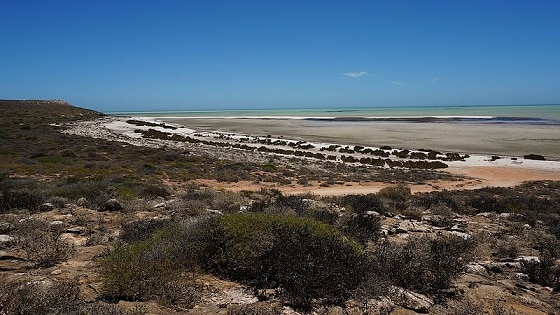
The future for the leaf-scaled sea snake seemed truly apocalyptic – until 2015. That was the year when an entire new population of the species was discovered in Shark Bay, 1100 miles from Ashmore and Cartier Island.
The last survey in the old heartlands had been in 2012, which again came up short. However, anecdotal sightings had been trickling from Australia’s west coast. So a team of scientists embarked on a 60 hour scouring of the nearby ocean floor, using scuba divers and snorkelers. They spent a further 25 hours with a manta tow, a small boat dragging along an underwater snorkel diver. They spent two hours searching for Aipysurus foliosquama at low tides and even investigated prawn trawler bycatch for snakes caught up in the netting.
The result was two species rescued from extinction: Aipysurus foliosquama and the short-nosed sea snake, which were both found in Shark Bay, an ecologically rich world heritage site 500 miles north of Perth. The discovery didn’t just expand the range, but the habitat of the species, as these snakes inhabited sea grass on the seabed rather than coral reefs. 16 leaf-scaled sea snakes were found in Shark Bay in total.
| 8 | They could be hiding everywhere |
There were hints for decades before this grand resurrection that the situation might be rosier than the headlines. In the 1970s, a short-scaled sea snake had been discovered off the Timor Coast, far from Ashmore and Carter islands. Scientist doubted that this belonged to a breeding colony, deeming it to be a long lost snake thrown far across the ocean by a ferocious cyclone.
But in 2010, more questions were raised when a dead leaf-scaled sea snake was handed to the Western Australian Museum, having originated in Barrow Island, an equally far location from the species’ capital. In 2014, scientists got to work and conducted a morphological examination of the Barrow Island snake, counting its scale numbers. The verdict brought new hope, as the snake was clearly a member of Aipysurus foliosquama, but had subtle genetic differences which pointed to an entirely separate colony rather than a long lost stray.
Better yet, similar rogue sightings have occurred near Port Hedland, slightly further north. Far from extinct, the leaf-scaled sea snake might be laughing as it escapes all human view and hears rumours of its own demise.
| 9 | What do they eat? |
The leaf-scaled sea snake eats fish and eels, although its full menu hasn’t been researched yet. Scientists have found only a handful of species in its stomach, all citizens of the colourful, winding alleyways of coral reefs. For example, they’re confirmed to eat sleeper gobies (eleotridae) and Tripterygion members, but one of their most common prey species is the threespot wrasse (Halichoeres trimaculatus).
This fish measures 20cm and dwells in coral reefs, with the exact colouring you might expect: a light purplish body followed by a yellow face, sometimes with patches of deeper purple. This fish was discovered in the stomach of three different leaf-scaled sea snakes, in one of the earliest ever studies on the species back in 1926. Threespot wrasses eat crustaceans and mollusks, before being eaten themselves by sea snakes. Such is life in the food chain.
The leaf-scaled sea snake has one of the wider diets of its 9 strong Australian family. Aipysurus eydouxii (the beaded sea snake) has a diet consisting exclusively of fish eggs and has even devolved to have no fangs.
| 10 | More leafy facts |
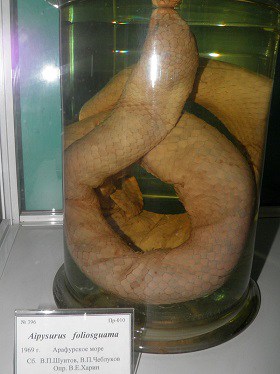
Leaf-scaled sea snakes are a relatively small snake at 60-90cm long. It’s a small and slender species with a pointed snout, which is usually solitary but sometimes spotted in groups in particularly cosy spots within coral reefs. Leaf-scaled sea snakes aren’t particularly dazzling, with a consistent light-brown to purplish-brown colour. However, they sometimes have white spots or markings on their flanks, and the borders of individual scales can darken.
The standout feature, of course, is their overlapping scales in the shape of autumn leaves which give them their name. As an ancient 1926 paper put it: “These have an extensive free margin, sometimes less than half the scale being attached to the body“. It wouldn’t be wise to rub your hand along this snake. Aipysurus foliosquama is the only member of the 9 strong family to have these leaf-shaped scales.
The leaf-scaled sea snake has round, black pupils, but its irises seem to vary by location. On Ashmore Reef they’re red-orange, while the dead Barrow Island snake had blue irises. Meanwhile, the yellow-bellied sea snake (a common species) has a blue-black iris.
can post a food chain of what they eat pls i need it for my assessment :’D
Use this article plus this one: http://www.environment.gov.au/cgi-bin/sprat/public/publicspecies.pl?taxon_id=1118